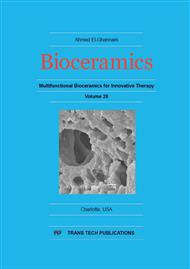p.180
p.185
p.189
p.193
p.197
p.203
p.207
p.210
p.215
Temperature Influence on the Calcium Phosphate Coatings by Chemical Method
Abstract:
The increasing interest in the use of brushite and monetite as resorbable calcium phosphate cements or graft materials is related to the fact of these phases being metastable under physiological environment, with higher solubility than hydroxyapatite phase. In this study, X-ray diffraction (XRD) and scanning electron microscopy with field emission gun (FEG-SEM) analyses were performed in order to assess the temperature influence on the production of calcium phosphate coatings by a chemical deposition method. Titanium substrates were successfully coated with brushite and monetite by a chemical deposition method and a brushite-monetite transformation was assessed with the increasing temperature. Brushite deposition was kinetically favored at low temperatures, whereas monetite was the major phase at higher temperatures.
Info:
Periodical:
Pages:
197-200
Citation:
Online since:
November 2016
Keywords:
Price:
Сopyright:
© 2017 Trans Tech Publications Ltd. All Rights Reserved
Share:
Citation:


